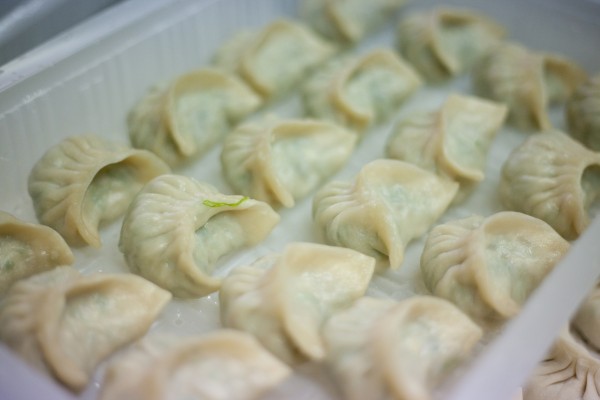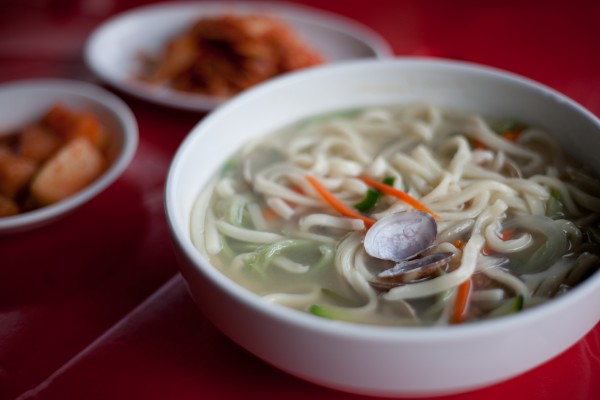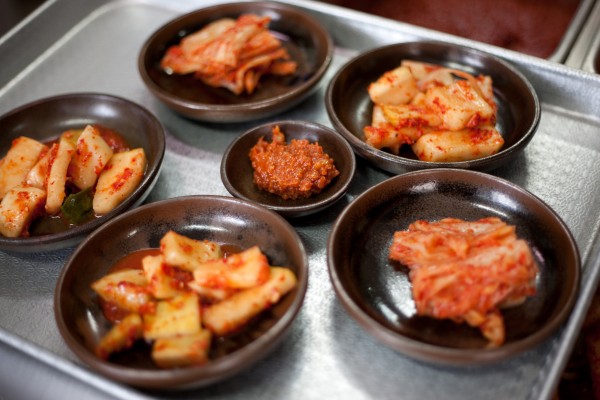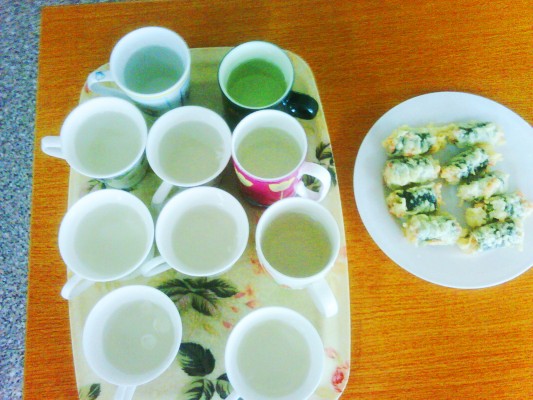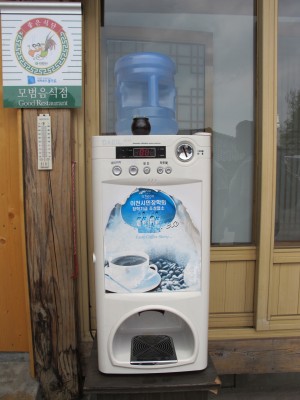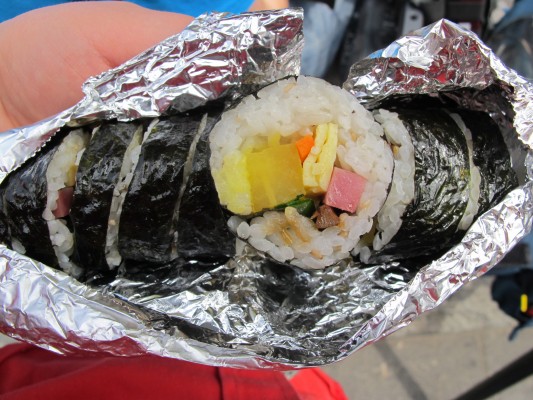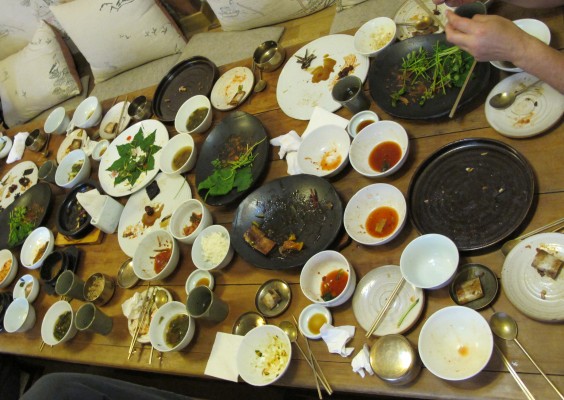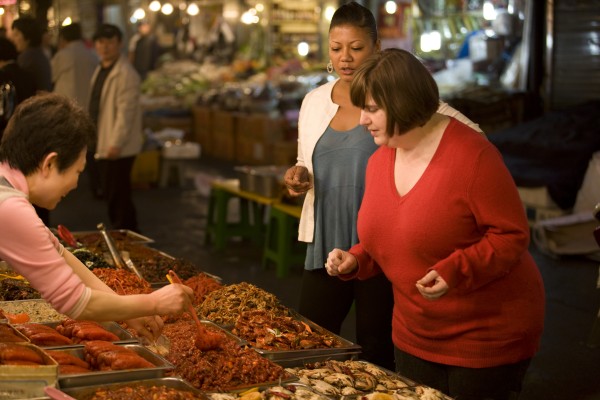
Jennifer and Marja at Gwangjang Market
Jennifer Flinn is a blogger for FatManSeoul, where she chronicles all things food in Seoul. She’s a major player in Korea’s food scene, and we were thrilled to feature her in Kimchi Chronicles. Dining alongside Marja and Diana, she impressed us all with her encyclopedic knowledge of Korean food. Read on for more about some of her thoughts about the show, Korean food, and more!
You appear on the show as one of Marja’s frequent dining companions. What is one of your best memories during filming?
Oh, there are too many good memories to choose from! Perhaps the most fun was the last day of filming, when we sat in a street food tent and played drinking games, but then we also had such a great time interacting with the vendors when we filmed in Gwangjang Market! It’s just such a welcoming place, and all the people running stalls there were so enthusiastic about telling us about the food. That warmth really just made filming there a joy. Of course the most entertaining moment was probably when I had just given dire warning about eating galchi (beltfish) carefully so you didn’t choke on the bones and then promptly choked on a bone. I sincerely hope that moment ended on the cutting room floor. It was funny, but definitely not going to aid my professional reputation.
How long have you been living in Korea, and why did you decide to move there?
I’ve lived in Korea off and on for nearly a decade now. I came several times as a student and on grants and fellowships, so I’ve been very lucky to be able to study the language and culture. My first trip was as an undergraduate when my college was invited to participate in a summer program, and although I had no real intention of studying Korea specifically, I just fell in love with the country. After that, I just kept coming back any way I could – I’ve spent time here as a student, a researcher, and just working.
Kimchi Chronicles is all about sharing Korean food with the world. What should people absolutely know about Korean food?
It’s much, much more diverse than people realize. Of course there are classic dishes like galbi and baechu kimchi that people are familiar with and think of as the taste of Korea, but there’s a whole other world of flavors beyond meaty and spicy! I love how Koreans use ingredients like ground wild sesame seed to flavor soups and stews, and how many different wild herbs and vegetables, some of which are only available in small parts of the country, come into play. But I also want people to know that there’s a really sophisticated dining scene here that includes some really innovative creations and brilliant combinations of flavors and textures that incorporate influences from around the world. There’s also lots of experimentation happening among ordinary restaurants and home cooks, who are using Korean ingredients and techniques in new ways. It’s a fascinating time here, and the food is changing all the time.
You’ve got one of the most popular food blogs in Korea. What drew you to pursue a career in food blogging?
Oh, I wish it were a career for me! But as a hobby, it’s a great way for me to continue to share Korean food with a wide variety of people and learn what else is going on. I’m very interested in taking an anthropological approach to food and finding ways to understand Korea through its food culture, but the blog is a way to take that interest and share all the exciting things I see with people who don’t necessarily want to read an academic article. Also, running the blog encourages me to keep going out there and documenting and learning about the cuisine! If anybody would like to pay for me to do this full time, I’d be ecstatic! In the meantime, I have a great time using the blog as a way to connect with people who are also interested in Korean food.
Jean Georges and Marja aside, who would you invite to your ideal dinner table?
Wow, that’s a tough question! How big is this table? Years ago, there was a PBS show hosted by Steve Allen called “Meeting of Minds” that was formatted like a talk show/dinner party for people like Shakespeare, Marie Antoinette, Cleopatra and other historical figures. It was such fun, I’m going to give you my historic dinner guest list:
I always thought Samuel Pepys would be the ultimate dinner guest. You have to appreciate a guy whose first concern during the Great Fire of London is the safety of his Parmesan cheese, and he’d make such an entertaining, gossipy guest!
Charles Darwin was a seriously adventurous eater, and I would love to hear firsthand about his travels and insights . . . and eats. He seems to have chowed down on as many animals as he studied (or maybe that was part of the studies?) and so you know he’s not a picky eater. Apparently he ate some delicious mystery rodents while he was in South America, and I’d love to know what they were . . . Dog soup would seem downright tame after all that.
Lady Jang (full name unknown) was a yangban woman from the Andong area who wrote the Eumsik Dimibang (also known as the Gyugon Siuibang), the oldest known female-authored cookbook in Korea way back in the 17th century. Not only does she cover an enormous number of dishes, she’s got a huge amount of information on alcoholic beverages, so she was obviously a lady who knew how to throw a party. I’d really love to hear what she thinks of modern Korean food.
I’ll make one exception to my historic guest list and say that more than anybody, I want to dine with Japanese food writer and critic Kishi Asako. It’s terribly cheesy, but I cut my foodie teeth on Iron Chef, and the “East German Judge” was always the highlight of the show. In my crazy imagination, she and Lady Jang would team up to critique the dinner a la Statler and Waldorf. I think I’d get a weird kick out having Kishi criticize my cooking, and certainly I’d learn a lot from the experience!
